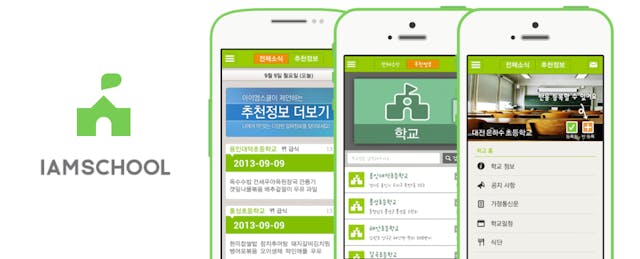It’s no secret that South Koreans are crazy about education. Korea regularly ranks in the top five countries in global student performance assessments such as the Organisation for Economic Co-operation and Development (OECD’s) Programme for International Student Assessment (PISA). Surveys have also shown that Korean students study several more hours a day than adolescents in other OECD countries. Korean students typically attend tutoring academies called hagwons after their school day ends and don’t return home until late in the evening.
Given the emphasis placed on education in Korea and the long hours Korean students log in classrooms, Korean parents are eager to receive regular updates from their children’s schools and hagwons. About 650,000 of these parents have found a solution in a free Android and iPhone app called IAMSCHOOL. The year-old app funnels school announcements and class notices to parents’ smartphones using a format similar to Twitter and Google+. Schools publish text updates and photos and parents register to receive updates from particular schools. Unlike Twitter, however, IAMSCHOOL updates can be made private, have no word limit, and can include downloadable files, such as permission slips or other documents. IAMSCHOOL also gives parents access to school event calendars and cafeteria menus and has an alarm function so parents know when their children’s schools release news.
IAMCOMPANY, the Korean startup that created IAMSCHOOL, says 80% of elementary, middle, and high schools across the country have registered to use the app. That figure, along with the number of users, makes IAMSCHOOL the most popular education information app in Korea. Chris Kim, IAMCOMPANY’s content director, says the app also qualifies as Korea’s most popular education app if educational content apps, such as online lectures or math games are excluded.
IAMCOMPANY grew out of a 2011 startup competition at KAIST, Korea’s leading science and technology university. KAIST student Inmo (Ryan) Chung placed first in the competition with an early version of IAMSCHOOL, then continued to refine the app and founded IAMCOMPANY in 2012. The startup currently employs about 20 people in Bundang, a tech-hub district near Seoul.
Its next step: expansion into China, Singapore, and other East Asian countries. On August 10 and 11, IAMCOMPANY representatives, including CEO Chung attended the TechCrunch Beijing startup competition and exhibition to gain exposure in China. IAMCOMPANY is also planning an entry into the Singaporean market. The startup developed a beta Singaporean version of its app last year when Chung visited the country as part of K-App Global Hub, a Korean government-sponsored program that trains and mentors Korean startups and helps promote them globally.
Choong-yeub Lee, IAMCOMPANY’s vice president and product manager, says China and Singapore are a natural extension for IAMSCHOOL because parents in those countries tend to have a high degree of involvement in their children’s education. “Chinese parents think about education the way Korean parents do,” says Lee. The start-up is also eyeing Taiwan and Japan as potential markets.
IAMCOMPANY’s strategy has attracted the support of noted Silicon Valley tech investor Tim Draper, as well as Korean venture capitalists, education, and technology companies. Lee says Draper made a personal, six-figure investment in IAMCOMPANY in July after the company appeared on a ‘Shark Tank’-like Korean TV show in which startups pitch ideas to a panel of judges. Since January 2013, IAMCOMPANY has also received $290,000 in seed funding and $968,000 in Series A funding from Korean VCs and a $290,000 strategic investment from Korean tech companies, Sigong Media and Sigong Tech.
The startup isn’t profitable yet, but Lee says it generates $50,000 in revenue a month from registration fees for its online publishing platform, IAMCLASS. IAMCLASS is a proprietary system, similar to Blogger or WordPress, that enables educational organizations to publish information on IAMSCHOOL. (As Lee puts it, “IAMCLASS is like the Twitter text box [where people compose tweets] and IAMSCHOOL is like the Twitter newsfeed.”) Schools can use IAMCLASS for free, but for-profit institutions, such as hagwons, must pay for access. In addition, some educational magazines publish articles within the IAMSCHOOL app to increase their readership. Those magazines also pay IAMCOMPANY for access.
It’s a business model that positions IAMSCHOOL as a versatile content platform, not just an app. Lee says IAMCOMPANY found inspiration in mobile messaging apps like KakaoTalk, the Korean competitor to WhatsApp, which has become a multi-faceted mobile communications and content platform. “Kakao made a platform for [distributing and selling] mobile games,” Lee points out. “That’s what we’re looking to do, but for educational information.”
Though IAMCOMPANY is plotting its international expansion, the startup has room to grow at home, too. Lee says the Korean K-12 supplemental education market--meaning K-12 educational resources outside of public and private schools--is worth $22 billion a year. That means there are a lot more hagwons, educational magazines, and other education providers that might pay to be part of the IAMSCHOOL platform.


